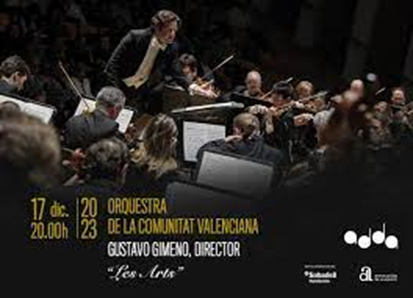This was a very special concert. It will live in the memory for as long as breath continues. It was nothing less than a triumph of artistic direction on behalf of Josep Vicent. All three featured works were, in their own way, quite recent, given the often-backward-looking character of concert programmes.
The evening began with a short, modern masterpiece. The program notes suggested that in our era, true myth (an oxymoron if ever there was one) is found not in characters of ancient Greek epics, but in the celebrities that populate our minds during waking hours. John Adams’s opera, Nixon in China, characteristically set recent events to music on a stage. Part of the opera’s point is that those figures involved in making history also have lives to live. John Adams cast Chairman Mao and his wife as dancers and the music to accompany this is The Chairman Dances, a Foxtrot for Orchestra.
It begins with a minimalist-sounding incessant rhythm, but in a moment of true magic, transforms itself into an almost sentimental dance, as if the celebrities forget themselves for a short time, and suddenly become human. Order does reassert itself as responsibilities and public faces re-emerge. The orchestral sound of this piece is vivid and multi-layered, but it does remind us continually that the clock rules rhythm, and perhaps our lives. It certainly rules the dance.
Second on the ADDA programme was Brahms’s Clarinet Sonata Opus 120. But this version was orchestral, the arrangement provided by Luciano Berio in 1986. Berio did not change Brahms’s original concept, but filled it out, so it occupied bigger space, even suggesting the concerto form. He was faithful to Brahms’s intention and this intimate, highly personal and lyrical work is now capable of filling a concert hall, though gently and in its original character. Patrick Messina as soloist gave a perfect (there is no other word) performance, totally controlled, completely in sympathy with the music. It was a performance with a humility that brought out the intentional understatement of the work. As an encore, we were treated to a more classical use of the clarinet with string accompaniment, again an arrangement.
The second half was given to a single work, a performance of Luciano Berrio’s Sinfonia for orchestra and amplified voices. The voices in question were London Voices, who seemed wholly at home with the highly multidimensional and unusual format of the piece.
Berio’s concept seems to grow spontaneously out of the experience of a twentieth century city. Charles Ives had at the start of the century chose impressionistic experience to portray the complexity of modern life. In his Sinfonia, Luciano Berio offered similar experience, but one on speed by comparison with that of Ives. An apparent jumble of sights, sounds, intellectual stimuli, musical references, passing comments and literary memories appear and combine to create a vivid, surreal collage, which deliberately does not hang together. It doesn’t because modern life is itself multidimensional, confused, confusing, stimulating, threatening and tender all at the same time. If I have one minor criticism, it is that the spoken text of the voices was not sufficiently prominent. Whether this matters is a matter of opinion. When visual art, for instance, features a raft of text, surely its effect is lost when viewers have to both read it and translate it. It may be the same with the words that Berio featured in this work. The word Majaskowsky did, however, hang in clean air. The text, by the way, is as collage-like as the music. It’s not a narrative, and is influenced by, amongst others, James Joyce and Samuel Beckett. Absurdity rules. This was thoroughly memorable music, and it was stunningly performed by the singers and musicians alike.
In this performance, Josep Vicent chose to play this work in its original four movements. Berio did add a fifth, but I think the logic might have been to create space for the encores, which in their way added to the collage-like experience. Berio quotes extensively from Mahler in his Sinfonia. As an encore, this led to a performance of the Adagietto from the fifth symphony. After the apparent anarchy of the Berio, the long lines made a peaceful and beautiful contrast. Then, when we all thought the pastiche could not get richer, London Voices, with the accompaniment of a brushed drum, gave a fugue in a cappella jazz style with an upbeat rhythm. Let’s not try to explain. Let’s just listen.










